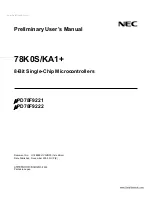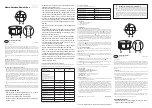
that your batteries are properly charged, set your voltmeter to 24V and connect the
voltmeter’s negative lead to the BLACK ground wire at the regulator. Normally, con-
nection is accomplished by inserting the negative lead alongside the ground wire in
the regulator harness plug (see
Figure 19
) and the positive lead alongside the wire
referred to in each specific test. With the voltmeter securely connected to the regula-
tor’s ground, test for voltage at the points listed below.
1.
With the ignition in the OFF position and your voltmeter’s ground wire con-
nected to the regulator’s ground, check for voltage on the RED (sensing),
BLUE (field) and BROWN (ignition) wires in the regulator plug by inserting the
positive lead of the voltmeter alongside each wire in the regulator harness
plug. The voltmeter should read:
Red Wire
Brown Wire
Blue Wire
Expected Reading
24 V *
0 V
0 V
Your Reading
2.
With the ignition in the ON position (engine not running) and your voltmeter’s ground wire connected to the regulator’s ground, check
for voltage on the RED (sensing), BLUE (field) and BROWN (ignition) wires in the regulator plug. The voltmeter should read:
Red Wire
Brown Wire
Blue Wire
Expected Reading
24 V*
24 V
>24 V
Your Reading
3.
With the ignition in the ON position (with engine running at 1,400 rpm fast idle) and your voltmeter’s ground wire connected to the reg-
ulator’s BLACK wire, check for voltage on the RED (sensing), BLUE (field) and BROWN (ignition) wires in the regulator plug. The volt-
meter should read:
Red Wire
Brown Wire
Blue Wire
Expected Reading
24 - 28V**
24 V
>25 V
Your Reading
* 23-24.5 VDC battery voltage at rest (no charging occurring). If your batteries are isolated and your RED (sensing) wire shows voltages other than those shown above, make sure
that the wire is connected on the “battery” side of the isolator. The RED wire must “see” the battery directly.
** 27 - 28 VDC battery voltage when charging.
If your readings differ substantially from the “Expected Readings” listed in the charts above, the regulator may be malfunctioning, or there
may be a continuity problem. Contact our technical support staff at (360) 435-6100. Keep your recorded readings in the spaces provided
below the “Expected Readings” so you can share them with the technical support person. If your readings match those listed in the charts,
your regulator should be working correctly. Continue with tests below to determine if your alternator may be the source of charging difficul-
ties.If the preceding tests do not prove the existence of a failure within the regulator or alternator, we recommend you contact a licensed
marine electrician who can test your system for wiring and circuit damage or other system failures that could be responsible for charging dif-
ficulties. If you determine that repair service is necessary for either your alternator or regulator, please gather the following information before
contacting our service technicians.
1.
Model of alternator.
2.
Model of voltage regulator.
3.
Voltage readings on red, brown and blue wire at regulator with engine off, key on.
4.
Voltage readings on red, brown and blue wire at regulator with engine running at a fast ideal 1400 rpm.
- 8 -
XII. LIMITED PRODUCT WARRANTY
BALMAR warrants to the original consumer/purchaser the product is free from any defects in material or workmanship for a period of one year from the date of purchase. If any
such defect is discovered within the warranty period, BALMAR will replace the regulator free of charge, subject to verification of the defect or malfunction upon delivery or ship-
ping prepaid to BALMAR.
This warranty DOES NOT apply to defects or physical damage resulting from abuse, neglect, accident, improper repair, alteration, modification, or unreasonable use of the prod-
ucts resulting in breakdown, cracked or broken cases nor are parts damaged by fire, water, freezing, collision, theft, explosion, rust, corrosion or items damaged in shipment in
route to BALMAR for repair. BALMAR assumes no responsibility for consequential damage or loss or expense arising from these products or any labor required for service or
repair.
BALMAR WILL NOT repair or be held responsible for any product sent without proper identification and return address or RA number clearly marked on the package. You must
include proof of date and place of purchase (photocopy of purchase invoice) or we cannot be responsible for repairs or replacement. In order to expedite warranty claims more
efficiently, BALMAR asks that prior to returning a defective product for repair, you call their customer service department for a warranty return authorization number .
If factory service is required, you can contact our BALMAR Customer Service Department Monday through Thursday, 7:30 AM to 5:30 PM, (PST)1-360 435-6100 ext “3”.
Material required for the repair or replacement for the defective part or product is to be supplied free of charge upon delivery of the defective regulator to BALMAR, 19009 61st
Ave. NE, Arlington, WA 98223. Customer is responsible for all return transportation charges and any air or rush delivery expense. BALMAR reserves the right to determine whether
to repair or replace defective components.
THE ABOVE LIMITATIONS MAY NOT APPLY TO YOU. SOME STATES DO NOT ALLOW LIMITATIONS ON HOW LONG AN IMPLIED WARRANTY LASTS. NO PERSON,
AGENT, DEALER IS AUTHORIZED TO GIVE ANY WARRANTY.
!"#$"%
19009 61st Ave. NE, Arlington, WA 98223 Phone: (360) 435-6100, Fax: (360) 435-3210
E-mail: [email protected], Web: www.balmar.net
Figure 19 -
Inserting voltmeter probes.


























